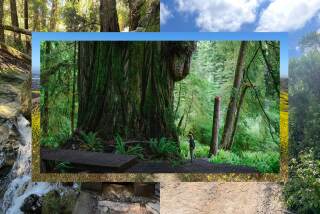Natural Cures
So you think poison oak is a horrible plant whose only function is to cause severe rashes?
Then prickly pear, a cactus with a barbed spine, can’t be much better. It’s covered with sharp thorns that can be quite painful.
Believe it or not, both plants have medicinal value, despite their negative reputation.
Though seven out of 10 people in the U.S. are sensitive to poison oak, it’s a highly effective wart remover and has been known to cure ringworm.
Prickly pear can heal burns, cuts, bruises and dog bites. Its pear-shaped pad--minus the thorns--has even proven to be effective when used on the swollen faces of mumps patients.
Interesting stuff? These are just some of the things you’ll learn Saturday in a free workshop called “Plant Uses--Medicine 101,” offered by the National Park Service.
Rangers Dana Dierkes and CQuvator Gatson will take a group of 25 to 30 people on an informative two-hour walk at the Rancho Sierra Vista Satwiwa site near Newbury Park.
“I’ve always had an interest in plant uses and, as I’ve walked around parkland, I’ve looked for different plants and researched what they do,” Dierkes said. “Some of the information is amazing.”
And Dierkes wanted to share her findings with the public, so she teamed up with Gatson and created a three-part series of workshops on plants.
The first dealt with edible plants, the second is Saturday’s medicinal workshop and the third, called “Practical Uses for Plants,” will be offered Dec. 6 at the same site.
That session will feature demonstrations on how certain plants can be used for shelter, clothing and tools. An example is the use of yucca fibers to make a rope, and walnuts and sunflowers to dye fabric.
Saturday’s medicinal session begins with a short walk near the picnic tables of the Satwiwa Cultural Center. The group then walks around the creek bed and pond, where rangers point out a variety of plants with medicinal value.
“We want to show the plants in their natural state,” Dierkes said. “We want to make sure you can identify them properly.”
Among the plants the tour encounters is horehound, a mint family member with fuzzy white leaves that was considered to be a cure-all in the 19th century. Dierkes says horehound, named after the Egyptian god Horus, has been known to cure everything from colds to diarrhea.
Another is dandelion, a weed with yellow flowers used to treat skin ailments such as acne as well as such conditions as indigestion, diabetes and jaundice.
Then there are willow and mustard seed, both remedies for fever and colds. Willow, which is found near the water, contains the same substance found in aspirin.
Mustard plants, which can be more than 5 feet tall, contain seeds that are used to make a potent plaster. Besides treating colds, mustard paste has also been effective in combating bronchitis. And you thought mustard was just something you put on a hot dog!
“But raw mustard in excess can also be dangerous,” Dierkes said. “It can cause extreme irritation of the intestinal tract and can make you throw up.”
Dierkes cautions that besides knowing the proper dosage, it’s crucial to identify the plants correctly.
Though the Santa Monica Mountains National Recreation Area does not permit the public to pick any plants, a free permit to do so on U.S. Forest land may be easily obtained.
The nearest locations, Dierkes says, would be the Angeles National Forest and Los Padres National Forest.
“There’s a big danger in misidentification,” she said. “You really need to know what you’re dealing with.”
Dierkes and Gatson will spend about an hour demonstrating how to use the various plants after conducting a tour of the area.
“A lot of these plants were used a century ago, so we also like to tie them to life today,” Dierkes said. “For instance, we’ll put a bottle of aspirin next to a willow and show horehound cough drops and explain how both herbs have been used for years.”
BE THERE
Rancho Sierra Vista Satwiwa site near Newbury Park. Take the Ventura Freeway to Wendy Drive exit; south on Wendy Drive to Potrero Road, west to the park. “Plant Uses--Medicine 101” begins at 2 p.m. Saturday. Free. Information: 597-9192, Ext. 201.





